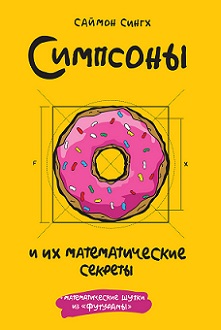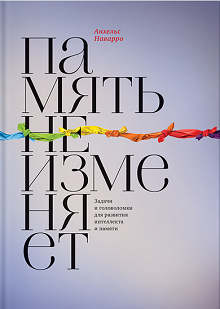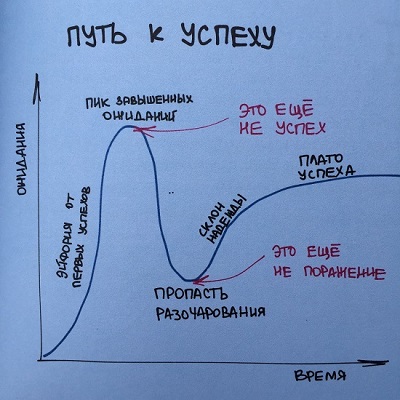What to read on New Year's holidays
We have compiled for you a collection of books that will help you to pump up useful skills for work and learn something new, without making any titanic efforts on yourself.
Simon Singh. "The Simpsons and Their Mathematical Secrets"
One of the best popular science books in mathematics, it is easy and pleasant to read.
 The author tells about the episodes of the animated series "The Simpsons" (and a little about "Futurama"), in which various mathematical ideas, concepts and formulas appear. Apparently, the creator of both serials Matt Greining (Wikipedia claims that his name is pronounced that way) is fond of mathematics and gladly inserts mathematical jokes and paradoxes into episodes.
The author tells about the episodes of the animated series "The Simpsons" (and a little about "Futurama"), in which various mathematical ideas, concepts and formulas appear. Apparently, the creator of both serials Matt Greining (Wikipedia claims that his name is pronounced that way) is fond of mathematics and gladly inserts mathematical jokes and paradoxes into episodes.
In the book there are a lot of jokes about Fermat's theorem, homeomorphic figures, Universe density, Sabermetric, Sophie Germain prime numbers, perfect numbers, narcissistic numbers, winning strategy in stone-paper-scissors, non-transitive dice, Grand Hotel paradox, Strashyla hypothesis, numbers e and π, Euler series, multidimensional spaces, and more.
')
If mathematics (or "The Simpsons") is of some interest to you, you, like me, will enjoy reading.
Grady Klein and Alan Debney. "Statistics. Basic course in comics »
 I often read information security analysis reports. At the same time, I pay special attention to the research methodology, description of boundaries and assumptions, I check and double-check the conclusions. Unfortunately, sometimes they contain logical errors, substitution of concepts, super-generalizations and other random or deliberate distortions.
I often read information security analysis reports. At the same time, I pay special attention to the research methodology, description of boundaries and assumptions, I check and double-check the conclusions. Unfortunately, sometimes they contain logical errors, substitution of concepts, super-generalizations and other random or deliberate distortions.
This book is interesting in the form of presentation of the material, funny examples, and, in general, a good and simple explanation of complex concepts and formulas used in statistics. It helps to better understand what is behind the data of various reports, surveys and studies. The book teaches how to detect errors and manipulations in statistical calculations, and therefore, to critically perceive information and understand whether to trust it.
 “How to lie with the help of statistics” by Daryl Huff is perhaps one of the most useful books on the subject of understanding quantitative research. This is not a novelty, the book was first published in 1954, but still does not lose its relevance.
“How to lie with the help of statistics” by Daryl Huff is perhaps one of the most useful books on the subject of understanding quantitative research. This is not a novelty, the book was first published in 1954, but still does not lose its relevance.
I really like that every way of manipulating statistics is illustrated by a real example. As a rule, distortions in the results of various studies are considered, with a very different level of significance - from the quality of toothpaste to the effectiveness of the polio vaccine.
Such an approach allows one to quickly and practically imperceptibly grasp the meaning and significance of such techniques.
Unfortunately, the book is not very well structured, so I myself give a list of the tricks described in it:
Angels Navarro. "Memory does not change"

The book, as the name implies, talks about how to develop and train memory.
In the first part, the author gives a bit of theory, which allows you to better understand how memory works: what types and phases it is divided into, what are its physiological bases, and also talks about what happens to it as a person ages and ways to avoid it.
Approximately 2/3 of the book devoted to the actual practical advice (up to power), as well as exercises. It is interesting to carry them out, and, in my opinion, it is enough to regularly allocate half an hour to this in order to notice progress soon.
The exercises themselves, for example, are:

Andrey Shapenko. “Comics about the world order. How to understand this world, pump yourself and achieve everything you want. "

Despite the disgustingly pathetic title, the book is really very pleasant. There is practically no “water” in it, it is easy to read and well structured.
Her ideas cannot be called breakthrough; rather, it is a set of well-formulated rational approaches to life stages / issues that often frighten people, making it difficult to move forward.
Here are a couple of quotes to make it clearer what I mean:
“Immediately to find out what you want from life, where you are moving, is very problematic. The fact is that today you may lack the knowledge and experience in order to see the image of the future where you would like to be. Trying different things, you begin to distinguish yours from others and understand what you really like. Do not know where you are going, do not be ashamed. It is a shame to sit and do nothing, suffering from the meaninglessness and futility of being. Let your goal for today be just a new way, and then you will figure it out. ”

“If every day to improve some business by only 1%, then in a year your efficiency in it will increase by 38 times. If you do 1% worse, then it is almost reset. "

I repeat, although you most likely will not find fantastic revelations in the book, but if there are changes waiting for you in the new year, it will help get rid of the irrational fears associated with them.

Good luck to you in the coming year!
Simon Singh. "The Simpsons and Their Mathematical Secrets"
One of the best popular science books in mathematics, it is easy and pleasant to read.
 The author tells about the episodes of the animated series "The Simpsons" (and a little about "Futurama"), in which various mathematical ideas, concepts and formulas appear. Apparently, the creator of both serials Matt Greining (Wikipedia claims that his name is pronounced that way) is fond of mathematics and gladly inserts mathematical jokes and paradoxes into episodes.
The author tells about the episodes of the animated series "The Simpsons" (and a little about "Futurama"), in which various mathematical ideas, concepts and formulas appear. Apparently, the creator of both serials Matt Greining (Wikipedia claims that his name is pronounced that way) is fond of mathematics and gladly inserts mathematical jokes and paradoxes into episodes.In the book there are a lot of jokes about Fermat's theorem, homeomorphic figures, Universe density, Sabermetric, Sophie Germain prime numbers, perfect numbers, narcissistic numbers, winning strategy in stone-paper-scissors, non-transitive dice, Grand Hotel paradox, Strashyla hypothesis, numbers e and π, Euler series, multidimensional spaces, and more.
')
If mathematics (or "The Simpsons") is of some interest to you, you, like me, will enjoy reading.
Grady Klein and Alan Debney. "Statistics. Basic course in comics »
 I often read information security analysis reports. At the same time, I pay special attention to the research methodology, description of boundaries and assumptions, I check and double-check the conclusions. Unfortunately, sometimes they contain logical errors, substitution of concepts, super-generalizations and other random or deliberate distortions.
I often read information security analysis reports. At the same time, I pay special attention to the research methodology, description of boundaries and assumptions, I check and double-check the conclusions. Unfortunately, sometimes they contain logical errors, substitution of concepts, super-generalizations and other random or deliberate distortions.This book is interesting in the form of presentation of the material, funny examples, and, in general, a good and simple explanation of complex concepts and formulas used in statistics. It helps to better understand what is behind the data of various reports, surveys and studies. The book teaches how to detect errors and manipulations in statistical calculations, and therefore, to critically perceive information and understand whether to trust it.
Daryl Huff. “How to lie with the help of statistics”
 “How to lie with the help of statistics” by Daryl Huff is perhaps one of the most useful books on the subject of understanding quantitative research. This is not a novelty, the book was first published in 1954, but still does not lose its relevance.
“How to lie with the help of statistics” by Daryl Huff is perhaps one of the most useful books on the subject of understanding quantitative research. This is not a novelty, the book was first published in 1954, but still does not lose its relevance.I really like that every way of manipulating statistics is illustrated by a real example. As a rule, distortions in the results of various studies are considered, with a very different level of significance - from the quality of toothpaste to the effectiveness of the polio vaccine.
Such an approach allows one to quickly and practically imperceptibly grasp the meaning and significance of such techniques.
Unfortunately, the book is not very well structured, so I myself give a list of the tricks described in it:
- Biased selection.
- Too small sample, which could give a random result.
- Substitution of the object of study.
- Properly chosen average value (“the best” of one: arithmetic average, median or mode).
- Ignoring error and error probability.
- The use of pseudo-grounded numbers.
- Violation of causation.
- "Games" with scale graphs, signature axes and other visual design of the results.
- Representation of values in the form of pictures, the perception of which is strongly influenced by their area. At the same time, the difference of values is represented as a difference in the height of images
- "Games" with percentages (incorrect addition, the choice of a convenient primary), etc.
Angels Navarro. "Memory does not change"

The book, as the name implies, talks about how to develop and train memory.
In the first part, the author gives a bit of theory, which allows you to better understand how memory works: what types and phases it is divided into, what are its physiological bases, and also talks about what happens to it as a person ages and ways to avoid it.
Approximately 2/3 of the book devoted to the actual practical advice (up to power), as well as exercises. It is interesting to carry them out, and, in my opinion, it is enough to regularly allocate half an hour to this in order to notice progress soon.
The exercises themselves, for example, are:

Andrey Shapenko. “Comics about the world order. How to understand this world, pump yourself and achieve everything you want. "

Despite the disgustingly pathetic title, the book is really very pleasant. There is practically no “water” in it, it is easy to read and well structured.
Her ideas cannot be called breakthrough; rather, it is a set of well-formulated rational approaches to life stages / issues that often frighten people, making it difficult to move forward.
Here are a couple of quotes to make it clearer what I mean:
“Immediately to find out what you want from life, where you are moving, is very problematic. The fact is that today you may lack the knowledge and experience in order to see the image of the future where you would like to be. Trying different things, you begin to distinguish yours from others and understand what you really like. Do not know where you are going, do not be ashamed. It is a shame to sit and do nothing, suffering from the meaninglessness and futility of being. Let your goal for today be just a new way, and then you will figure it out. ”

“If every day to improve some business by only 1%, then in a year your efficiency in it will increase by 38 times. If you do 1% worse, then it is almost reset. "

I repeat, although you most likely will not find fantastic revelations in the book, but if there are changes waiting for you in the new year, it will help get rid of the irrational fears associated with them.

Good luck to you in the coming year!
Source: https://habr.com/ru/post/345854/
All Articles